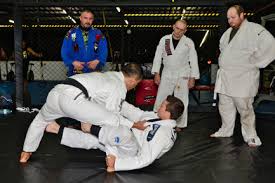Postulated hypothesis : “Advanced” techniques are those that require higher level of physical attributes or developed ability, are more complex and more involved (i.e. have more “moving parts”) and will happen in real world application only in outlier type situations.
There are some clichés in the self-defense training community, whether you come from the firearms or the martial art side. “They all fall to hardball”, “two is one, one is none”, “I know grappling because it is hidden in my katas”, “slow is smooth, smooth is fast”, etc. Any of them may have had decent roots in an authentic truth at some point, but they tend to get warped by overuse. “There is no such thing as advanced techniques, only applications done better” is one of those that I think has some basis in truth, but loses any benefit without nuance.
Let’s look at Jiu-jitsu for example. The majority of moves (certainly the moves you should build your game on) consists pretty much of essential fundamentals. Cross Collar Choke, Straight Armbar, Kimura, Flower Sweep, et al are ones that can be done successfully and often whether you are a white belt or a black belt. However, there are moves that cannot truly be considered non-advanced. Worm Guard and its attacks is a perfect illustration of this. If you have no idea of how open guard moves work and their important points, then pulling off any worm guard attack is going to be pure luck, and it will absolutely not be consistent. Because without that underlying conceptual grasp of open guard, then the only way to execute any word guard attack is by regurgitation from what the teacher said, and there is no way to do that well or reliably against true opposition by your peer. You will not know how to control the lapel, you will not understand how to apply pressure with your hands and feet to control the other person, and you will not understand how to adjust things on the fly. You must have a fundamental base first. Therefore, if you have to have that base first to do worm guard, then there is no way it can be considered anything but advanced.
Or if we look at Defensive Handgun, I have a hard time believing anyone would reasonably argue that doing weak hand only immediate action drills will be the equivalent of a giant cluster**ck if the first time you pick up a handgun you are taught to do WHO malfunction clearing techniques. I think it is safe to say that to be proficient at that, you have to have some decent ingrained gunhandling skills, and you probably should be okay at doing the same work with your primary hand. Once you have built a bit of familiarity on that side, going to the weak hand will be a bit more manageable. So again, a skill set that ahs to have some requirements before they can be understood and performed, and again, pretty much a definite indicator of it being a more advanced skill.
We also have applications. To be good at moving through a structure with a gun in your hand and working against a bad guy, you better have the shooting and handling portion down pretty solid. You will be using almost all of your cognitive powers on the task at hand, and you will have little to spare for making sure you align the sights and press the trigger properly. Once again, fundamental skills with the gun to be sure, but done in a manner that makes it far more advanced and you need far higher developed mechanics.
Look at the following video. Go to the 8:18 mark to see some room movement with a gun in hand and note how much of the brain is occupied with seeing and thinking about the movement, and the gunhandling has to be pretty automated.
Or with jiu-jitsu, sometimes to pull off a successful attack, you need to do more than a single direct action, and have to build on a complex and ongoing series of moves.
Take these worm guard attacks. Not only are the shown set ups more complex than something fundamental like a Flower Sweep, even the set up before this moment is complex and requires a good amount of effort and work. You are not just going to be able to get to the beginning part of the video straight away at the beginning of a roll. You are going to have to carefully get into the position just to begin the worm guard attack, let alone all the actions for the attack itself.
Make no mistake that this is any kind of argument to do spend more time working “advanced skills”. Rather, I think the Pareto Principle should be followed to some extent. That is, the 80/20 rule. So the bulk of our training should be focused on the fundamentals and what gets us the most bang for the buck, but it is not a bad thing to spend at least a small portion of our time on the advanced stuff.
It might seem pedantic to talk about this in this manner, but I think it is important to be clear in how we view and talk about the principles that might help keep us alive.

